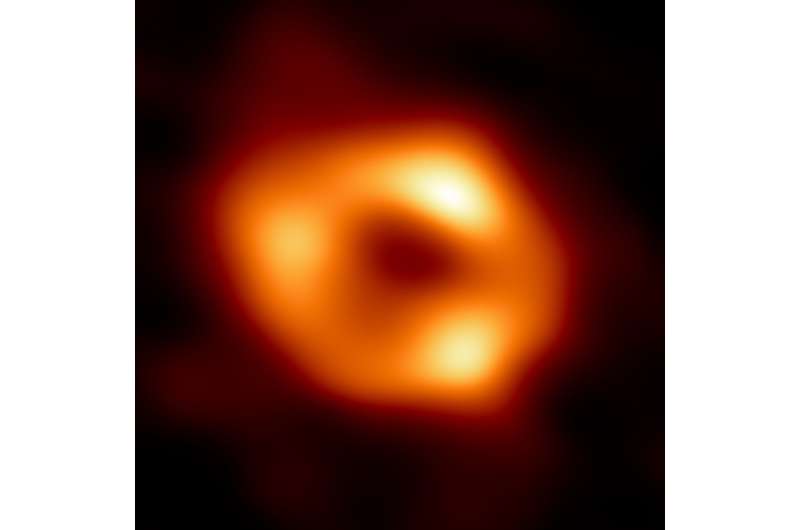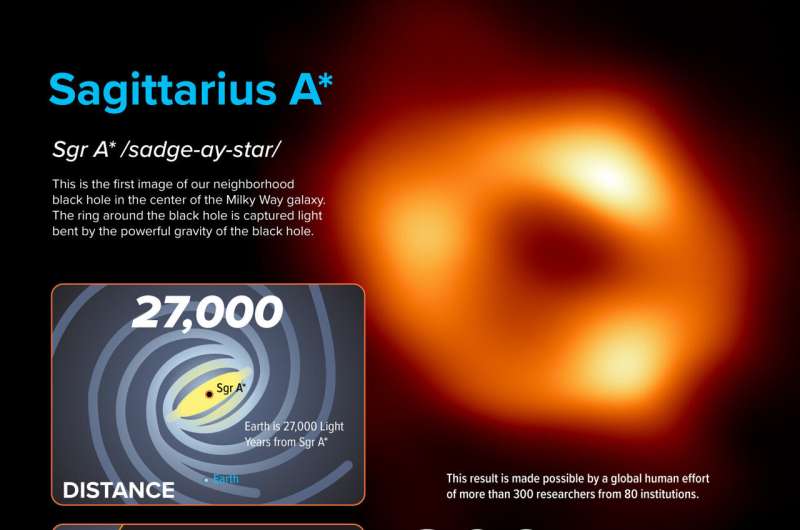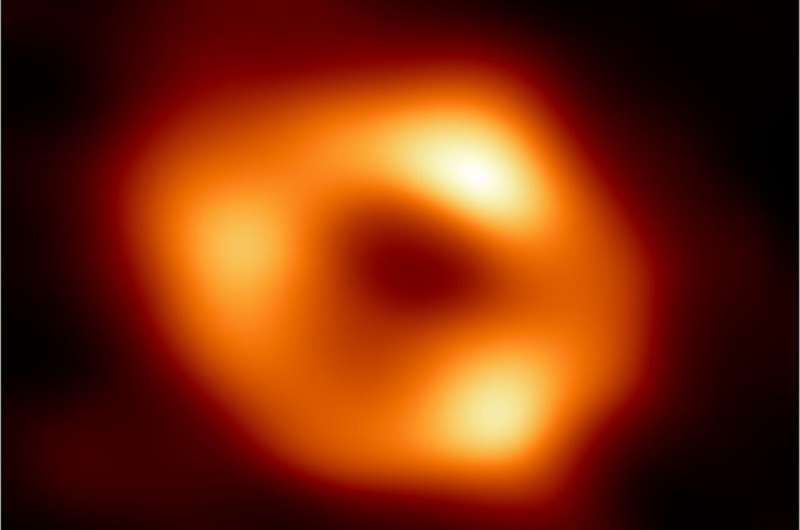Astronomers reveal first image of the black hole at the heart of our galaxy

At simultaneous press conferences around the world, including at a National Science Foundation-sponsored press conference at the U.S. National Press Club in Washington, D.C., astronomers have unveiled the first image of the supermassive black hole at the center of our own Milky Way galaxy. This result provides overwhelming evidence that the object is indeed a black hole and yields valuable clues about the workings of such giants, which are thought to reside at the center of most galaxies. The image was produced by a global research team called the Event Horizon Telescope (EHT) Collaboration, using observations from a worldwide network of radio telescopes.
The image is a long-anticipated look at the massive object that sits at the very center of our galaxy. Scientists had previously seen stars orbiting around something invisible, compact, and massive at the center of the Milky Way. This strongly suggested that this object—known as Sagittarius A* (Sgr A*, pronounced "sadge-ay-star")—is a black hole, and today's image provides the first direct visual evidence of it.
Read more: Snapping a black hole: How the EHT super-telescope works
We cannot see the black hole itself, because it is completely dark, but glowing gas around it reveals a telltale signature: a dark central region (called a "shadow") surrounded by a bright, ring-like structure. The new view captures light bent by the powerful gravity of the black hole, which is four million times more massive than our sun.
"We were stunned by how well the size of the ring agreed with predictions from Einstein's theory of general relativity," said EHT Project Scientist Geoffrey Bower from the Institute of Astronomy and Astrophysics, Academia Sinica, Taipei. "These unprecedented observations have greatly improved our understanding of what happens at the very center of our galaxy, and offer new insights on how these giant black holes interact with their surroundings." The EHT team's results are being published today in a special issue of The Astrophysical Journal Letters.
Because the black hole is about 27,000 light-years away from Earth, it appears to have about the same size in the sky as a donut on the moon. To image it, the team created the powerful EHT, which linked together eight existing radio observatories across the planet to form a single "Earth-sized" virtual telescope. The EHT observed Sgr A* on multiple nights, collecting data for many hours in a row, similar to using a long exposure time on a camera.
And just like a high-powered camera, imaging Sgr A* required the support of the most sensitive instruments in radio astronomy. That sensitivity comes from the 1.3mm Band 6 receivers on the Atacama Large Millimeter/submillimeter Array (ALMA), designed by the Central Development Laboratory (CDL) at the US National Science Foundation's National Radio Astronomy Observatory (NRAO).
"We are very proud at CDL to have provided some critical technology to support this amazing discovery by the EHT collaboration," said Bert Hawkins, Director of CDL, who explained the role of Band 6 and CDL in making the research and the results possible. "Our team contributed by installing a custom-built atomic clock on ALMA and reprogramming the ALMA correlator to make the telescope a phased array. This effectively turned the telescope into a single dish with an effective diameter of 85 meters– the largest component on the EHT. In addition, the mixers at the heart of the receivers on ALMA, the Submillimeter Telescope (SMT) in Arizona, the Large Millimeter Telescope (LMT) in Mexico, and the South Pole Telescope (SPT) in Antarctica were developed at CDL along with our partners at the University of Virginia."

The breakthrough follows the EHT collaboration's 2019 release of the first image of a black hole, called M87*, at the center of the more distant Messier 87 galaxy.
The two black holes look remarkably similar, even though our galaxy's black hole is more than 1,000 times smaller and less massive than M87*. "We have two completely different types of galaxies and two very different black hole masses, but close to the edge of these black holes, they look amazingly similar," says Sera Markoff, co-chair of the EHT Science Council and a professor of theoretical astrophysics at the University of Amsterdam, the Netherlands. "This tells us that general relativity governs these objects up close, and any differences we see further away must be due to differences in the material that surrounds the black holes."
This achievement was considerably more difficult than for M87*, even though Sgr A* is much closer to us. EHT scientist Chi-kwan ("CK") Chan, from Steward Observatory and Department of Astronomy and the Data Science Institute of the University of Arizona, U.S., explains: "The gas in the vicinity of the black holes moves at the same speed—nearly as fast as light—around both Sgr A* and M87*. But where gas takes days to weeks to orbit the larger M87*, in the much smaller Sgr A*, it completes an orbit in mere minutes. This means the brightness and pattern of the gas around Sgr A* was changing rapidly as the EHT Collaboration was observing it—a bit like trying to take a clear picture of a puppy quickly chasing its tail."

The researchers had to develop sophisticated new tools that accounted for the gas movement around Sgr A*. While M87* was an easier, steadier target, with nearly all images looking the same, that was not the case for Sgr A*. The image of the Sgr A* black hole is an average of the images the team extracted, finally revealing the giant lurking at the center of our galaxy for the first time.
The effort was made possible through the ingenuity of more than 300 researchers from 80 institutes around the world that together make up the EHT Collaboration. In addition to developing complex tools to overcome the challenges of imaging Sgr A*, the team worked rigorously for five years, using supercomputers to combine and analyze their data, all while compiling an unprecedented library of simulated black holes to compare with the observations.
"This work clearly demonstrates the critical importance of using radio, millimeter and submillimeter frequencies to understand the most extreme environments in the universe," said Tony Remijan, Director of the North American ALMA Science Center (NAASC) at NRAO. "Using these frequency ranges is the only way to uncover the unique environment surrounding the black hole that are completely obscured at other frequencies. The addition of ALMA was also critical to the observations as it provided the necessary sensitivity to unambiguously make this observation. Combining all the data from facilities all over the world—with ALMA as the anchor for all these facilities—provided the sensitivity and resolution needed to make these types of discoveries. And this is only the beginning. ALMA is planning a large increase to its sensitivity in the next decade, which will lead to even more profound discoveries awaiting us in the universe."
Scientists are particularly excited to finally have images of two black holes of very different sizes, which offers the opportunity to understand how they compare and contrast. They have also begun to use the new data to test theories and models of how gas behaves around supermassive black holes. This process is not yet fully understood, but is thought to play a key role in shaping the formation and evolution of galaxies.
"Now, we can study the differences between these two supermassive black holes to gain valuable new clues about how this important process works," said EHT scientist Keiichi Asada from the Institute of Astronomy and Astrophysics, Academia Sinica, Taipei. "We have images for two black holes—one at the large end and one at the small end of supermassive black holes in the universe—so we can go a lot further in testing how gravity behaves in these extreme environments than ever before."
Progress on the EHT continues: a major observation campaign in March 2022 included more telescopes than ever before. The ongoing expansion of the EHT network and significant technological upgrades will allow scientists to share even more impressive images as well as movies of black holes in the near future.
In 2021, NSF and the ALMA Board approved a multi-million dollar upgrade for the Observatory's Band 6 receivers through the North American ALMA Development Program. The upgrade will increase the quantity and quality of science measured in wavelengths between 1.4mm and 1.1mm, which will provide research projects like those at EHT with better sensitivity than ever before, and ultimately more accurate and more efficient science results. In addition, NRAO's Next Generation Very Large Array (ngVLA) received positive support from the Astro2020 decadal survey. Currently, in early-stage planning and development, the ngVLA will achieve high priority goals in astronomy and astrophysics and is slated to become the ultimate black hole hunting machine.
"These new results from EHT are exciting both because they show us how far astronomy has come already, and also because they confirm that there's still so much out there we haven't seen and haven't yet been able to observe and study," said Dr. Tony Beasley, Director of NRAO. "The antennas and instrumentation we design and develop at NRAO are making this progress possible, and we look forward to continuing to lead advances in radio astronomy that will uncover black holes and other phenomena lurking in the corners of the galaxy and the universe."
More information: The Astrophysical Journal Letters: iopscience.iop.org/journal/204 … _First_Sgr_A_Results
Kazunori Akiyama et al, First Sagittarius A* Event Horizon Telescope Results. I. The Shadow of the Supermassive Black Hole in the Center of the Milky Way, The Astrophysical Journal Letters (2022). DOI: 10.3847/2041-8213/ac6674 , iopscience.iop.org/article/10. … 847/2041-8213/ac6674
Kazunori Akiyama et al, First Sagittarius A* Event Horizon Telescope Results. II. EHT and Multiwavelength Observations, Data Processing, and Calibration, The Astrophysical Journal Letters (2022). DOI: 10.3847/2041-8213/ac6675 , iopscience.iop.org/article/10. … 847/2041-8213/ac6675
Kazunori Akiyama et al, First Sagittarius A* Event Horizon Telescope Results. III. Imaging of the Galactic Center Supermassive Black Hole, The Astrophysical Journal Letters (2022). DOI: 10.3847/2041-8213/ac6429 , iopscience.iop.org/article/10. … 847/2041-8213/ac6429
Kazunori Akiyama et al, First Sagittarius A* Event Horizon Telescope Results. IV. Variability, Morphology, and Black Hole Mass, The Astrophysical Journal Letters (2022). DOI: 10.3847/2041-8213/ac6736 , iopscience.iop.org/article/10. … 847/2041-8213/ac6736
Kazunori Akiyama et al, First Sagittarius A* Event Horizon Telescope Results. V. Testing Astrophysical Models of the Galactic Center Black Hole, The Astrophysical Journal Letters (2022). DOI: 10.3847/2041-8213/ac6672 , iopscience.iop.org/article/10. … 847/2041-8213/ac6672
Kazunori Akiyama et al, First Sagittarius A* Event Horizon Telescope Results. VI. Testing the Black Hole Metric, The Astrophysical Journal Letters (2022). DOI: 10.3847/2041-8213/ac6756 , iopscience.iop.org/article/10. … 847/2041-8213/ac6756
Journal information: Astrophysical Journal Letters
Provided by National Radio Astronomy Observatory





















